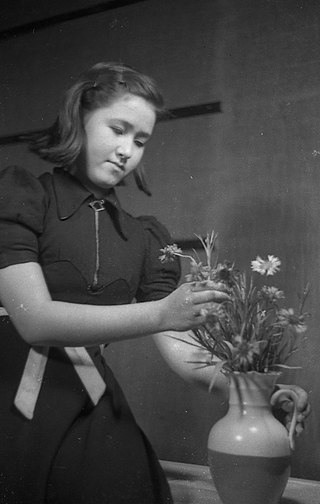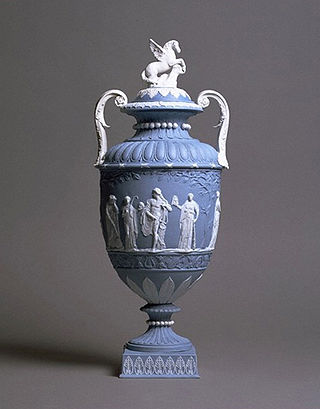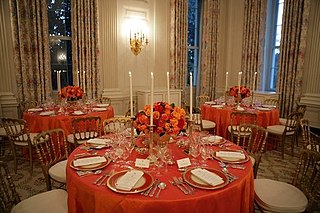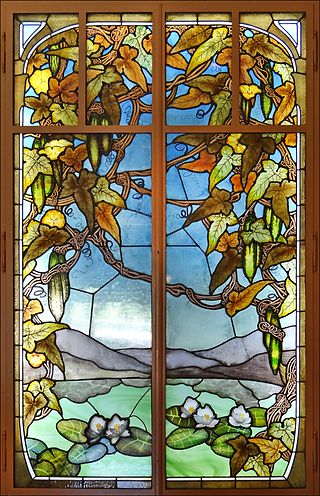
Émile Gallé was a French artist and designer who worked in glass, and is considered to be one of the major innovators in the French Art Nouveau movement. He was noted for his designs of Art Nouveau glass art and Art Nouveau furniture, and was a founder of the École de Nancy or Nancy School, a movement of design in the city of Nancy, France.

Floristry is the production, commerce, and trade in flowers. It encompasses flower care and handling, floral design and arrangement, merchandising, production, display and flower delivery. Wholesale florists sell bulk flowers and related supplies to professionals in the trade. Retail florists offer fresh flowers and related products and services to consumers. The first flower shop in the United States opened prior to 1851.

Constance Spry was a British educator, florist and author in the mid-20th century.

Floral design or flower arrangement is the art of using plant material and flowers to create an eye-catching and balanced composition or display. Evidence of refined floral design is found as far back as the culture of ancient Egypt. Floral designs, called arrangements, incorporate the five elements and seven principles of floral design.

Jasperware, or jasper ware, is a type of pottery first developed by Josiah Wedgwood in the 1770s. Usually described as stoneware, it has an unglazed matte "biscuit" finish and is produced in a number of different colours, of which the most common and best known is a pale blue that has become known as "Wedgwood blue". Relief decorations in contrasting colours are characteristic of jasperware, giving a cameo effect. The reliefs are produced in moulds and applied to the ware as sprigs.

Rocaille was a French style of exuberant decoration, with an abundance of curves, counter-curves, undulations and elements modeled on nature, that appeared in furniture and interior decoration during the early reign of Louis XV of France. It was a reaction against the heaviness and formality of the Louis XIV style. It began in about 1710, reached its peak in the 1730s, and came to an end in the late 1750s, replaced by Neoclassicism. It was the beginning of the French Baroque movement in furniture and design, and also marked the beginning of the Rococo movement, which spread to Italy, Bavaria and Austria by the mid-18th century.
Flower delivery is a service in floristry. In many cases it is conducted through websites which allow consumers to browse online catalogues of flowers. They are often delivered to a third party, the recipient of the gift. Historically, these were coordinated through telegraphs and later telephones before the advent of the World Wide Web.

The State Dining Room is the larger of two dining rooms on the State Floor of the Executive Residence of the White House, the home of the president of the United States in Washington, D.C. It is used for receptions, luncheons, larger formal dinners, and state dinners for visiting heads of state on state visits. The room seats 140 and measures approximately 48 by 36 feet.

The Vermeil Room is located on the ground floor of the White House, the official residence of the president of the United States. The room houses a collection of silver-gilt or vermeil tableware, a 1956 bequest to the White House by Margaret Thompson Biddle. Portraits of American First Ladies hang in the room.

A state banquet is an official banquet hosted by the head of state in his or her official residence for another head of state, or sometimes head of government, and other guests. Usually as part of a state visit or diplomatic conference, it is held to celebrate diplomatic ties between the host and guest countries. Depending on time of the day, it may be referred to as a state dinner or state lunch. The size varies, but the numbers of diners may run into the hundreds.

The floral industry is focused on the production, distribution and sale of flowers for human enjoyment. The floral industry began in the Golden Century of the Netherlands, where flowers were grown on a large scale on vast estates. The industry continues to diversify from the production of cut flowers to the production and sale of plants and flowers in many different forms. The global floral industry market size is estimated to be worth US$ 50040 million in 2022 and is forecast to increase to US$ 58030 million by 2028 with a compound annual growth rate of 2.5% during the review period.

The Office of the First Lady (OFL) is the staff accountable to the first lady of the United States. The office and its responsibilities, while not constitutionally mandated, have grown as the role of the first lady has grown and formalized through the history of the United States. The Office of the First Lady is an entity of the White House Office, part of the Executive Office of the President. It is located in the East Wing.

The White House china refers to the various patterns of china (porcelain) used for serving and eating food in the White House, home of the president of the United States. Different china services have been ordered and used by different presidential administrations. The White House collection of china is housed in the White House China Room. Not every administration created its own service, but portions of all china services created for the White House are now in the China Room collection. Some of the older china services are used for small private dinners in the President's Dining Room on the Second Floor.

The history of flower arrangement dates back to ancient Egyptian times.

The Texas State Florists' Association (TSFA) was founded in 1914 and is headquartered in Austin, Texas. Since its inception, the TSFA has grown into a professional trade association that covers many branches of the floral industry. Its membership base includes a diverse assortment of people in the floral industry, and it is involved in professional services and marketing in support of floral interests, state legislation, and the provision of educational opportunities. It represents the Texas floral industry, and has members in ten additional states. The organization hosts an annual convention, the first of which occurred in 1914. The TSFA sponsors the Texas Certified Florists Program, and publishes a monthly magazine named TEXAS in Bloom.

Cut flowers are flowers and flower buds that have been cut from the plant bearing it. It is removed from the plant for decorative use. Cut greens are leaves with or without stems added to the cut flowers for contrast and design purposes. These displays improve the quality of the human environment.

École de Nancy, or the Nancy School, was a group of Art Nouveau artisans and designers working in Nancy, France between 1890 and 1914. Major figures included the furniture designer Louis Majorelle, ebonist and glass artist Jacques Grüber, the glass and furniture designer Émile Gallé, and the crystal manufactory of Daum. Their work was largely inspired by floral and vegetal forms found in the region. The goal of the group was to produce in series ordinary objects, such as furniture, glassware, and pottery, with fine craftsmanship and in original forms, making art objects available for people's homes.
"The Carnation Gold Rush" is a term used by Denver locals, historians and preservationists to represent the period between the 1880s and 1930s when the floriculture industry developed and thrived in Colorado.
Patricia Easterbrook Roberts was an Australian-born floral designer, author, and landscape designer who worked in Australia, England and the United States.

The whiplash or whiplash line is a motif of decorative art and design that was particularly popular in Art Nouveau. It is an asymmetrical, sinuous line, often in an ornamental S curve, usually inspired by natural forms such as plants and flowers, which suggests dynamism and movement. It took its name from a woven fabric panel called "Coup de Fouet" ("Whiplash") by the German artist Hermann Obrist (1895) which depicted the stems and roots of the cyclamen flower. The panel was later reproduced by the textile workshop of the Darmstadt Artists Colony.

























